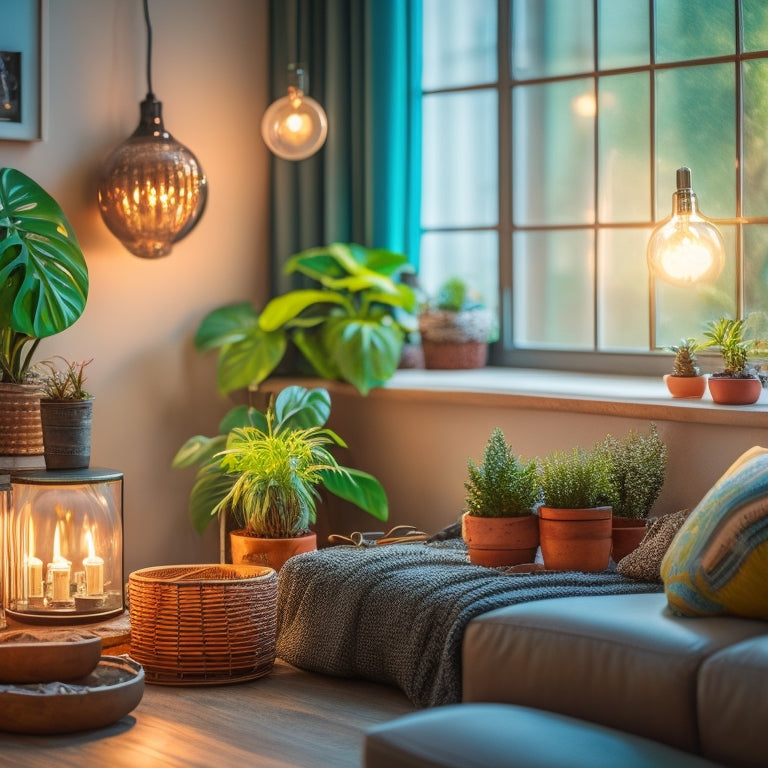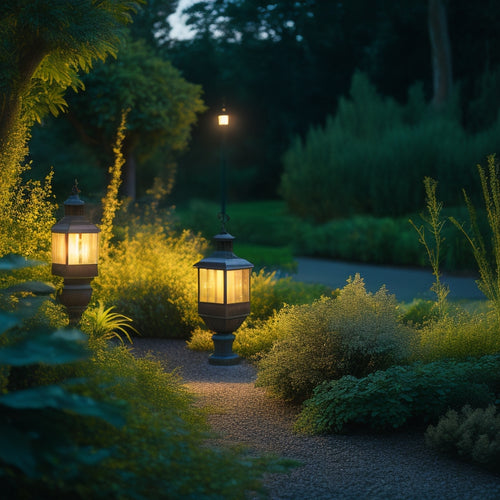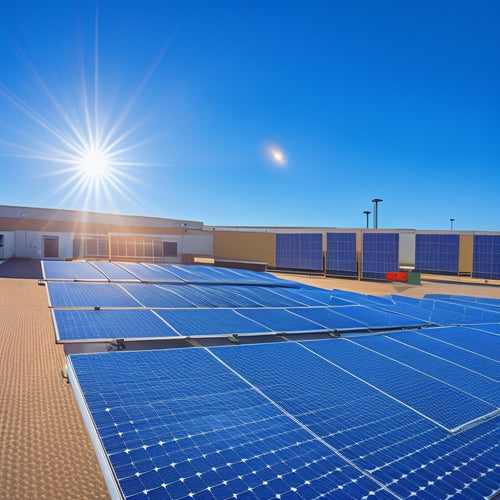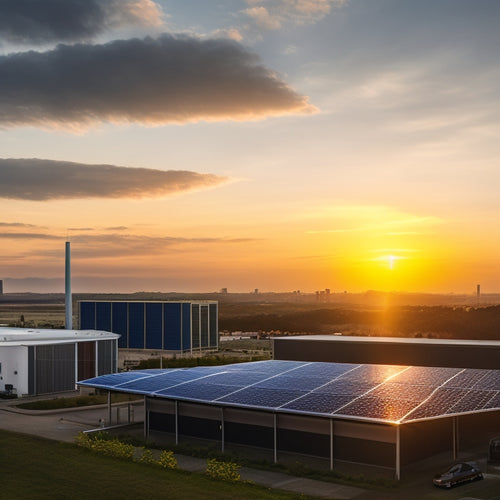
What Are the Best Energy Efficient Light Bulbs for Your Needs
Share
The best energy-efficient light bulbs for your needs include LEDs and CFLs, which last considerably longer than traditional options—up to 25,000 hours versus just 1,000. They not only lower your electricity bills by using up to 75% less energy but also reduce heat output, promoting a comfortable environment. Consider smart bulbs for added control, allowing you to adjust brightness and color easily. Think about your specific lighting needs, whether for cozy living rooms or task-oriented kitchens. With the right choices, you'll enhance efficiency while cutting costs, and there's even more to investigate about optimizing your lighting setup.
At a Glance
-
Energy-efficient bulbs, like LEDs and CFLs, last 10,000 to 25,000 hours, significantly reducing replacement frequency and overall costs.
-
While initial costs may be higher, energy-efficient bulbs can save up to 50% on utility bills over time.
-
Smart bulbs offer customizable features, including adjustable brightness and color-changing options, enhancing convenience and integrating seamlessly with smart home devices.
-
Brightness is measured in lumens; choose bulbs with around 800 lumens for cozy spaces and 1,500 lumens for task lighting in kitchens.
-
Select color temperatures based on room function: warm white (2700K-3000K) for relaxation and cooler light (5000K-6500K) for workspaces.
Longer Lifespan Than Traditional Bulbs
When you switch to energy-efficient light bulbs, you'll notice they often last much longer than traditional bulbs.
This extended durability not only reduces the frequency of replacements but also complements the financial benefits of energy efficiency, leading to lower electricity bills over time.
Ultimately, this longevity not only enhances convenience but also contributes to lower overall costs in your lighting expenses, allowing for savings that can be redirected towards other home improvements like solar panel installation.
Extended Usage Durability
How often have you found yourself replacing traditional incandescent bulbs, only to realize they just can't keep up with your lighting needs? It's frustrating, but that's where energy-efficient bulbs come into play, offering extended usage durability that traditional options simply can't match.
These bulbs, often made from advanced light bulb materials like LEDs and CFLs, are engineered to last considerably longer than incandescent bulbs.
Energy consumption is another essential factor in this equation. While incandescent bulbs burn out quickly, the innovative designs of energy-efficient bulbs reduce heat output and optimize light production.
This means you can enjoy bright, lively lighting for years without worrying about frequent replacements.
When you choose energy-efficient bulbs, you're not just saving yourself the hassle of constant replacements; you're also contributing to a more sustainable future.
Their longer lifespan translates into less waste, lower energy bills, and the freedom to focus on what truly matters in your life.
Reduced Replacement Frequency
Energy-efficient light bulbs greatly reduce replacement frequency, making them a smart choice for both your home and the environment. Unlike traditional incandescent bulbs, which often need replacing every 1,000 hours, energy-efficient options like LEDs and CFLs can last anywhere from 10,000 to 25,000 hours. This extended lifespan means fewer trips to the store and less hassle in maintaining your lighting.
The advanced bulb materials used in these energy-efficient options contribute considerably to their longevity. For instance, LEDs rely on solid-state technology, which is inherently more durable than fragile filament-based designs.
This durability not only cuts down on replacements but also lessens the environmental impact of manufacturing and disposing of light bulbs. Fewer replacements mean reduced energy and material consumption over time, which is a win for both your wallet and the planet.
Cost Savings Over Time
When you consider switching to energy-efficient light bulbs, it's essential to weigh the initial purchase costs against the long-term savings.
While these bulbs may have a higher upfront price, their lower energy consumption can greatly reduce your electricity bills over time, leading to potential savings of up to 50% or more on your utility costs notable energy savings.
Ultimately, the investment pays off, making your choice not just eco-friendly but also economically savvy.
Initial Purchase Costs
The upfront costs of energy-efficient light bulbs can often seem intimidating compared to traditional incandescent options. However, it's crucial to conduct an initial investment analysis to understand their true value. While you might spend more at the register, these bulbs typically last much longer and consume considerably less energy, leading to substantial long-term savings.
When looking at budget considerations, consider the number of bulbs you need and their expected lifespan. For instance, LED bulbs can last up to 25,000 hours, whereas incandescent bulbs usually last around 1,000 hours. This longevity means fewer replacements over time, which can offset that initial higher cost.
Moreover, energy-efficient bulbs often come with warranties that guarantee performance, adding extra value to your purchase. By investing in these bulbs now, you're not just lighting your space; you're making a choice that aligns with a more sustainable lifestyle.
Long-Term Energy Savings
Switching to energy-efficient light bulbs can lead to significant cost savings over time. While the initial investment might be higher, the reduction in energy consumption quickly offsets that cost. For instance, LED bulbs use about 75% less energy than traditional incandescent bulbs, translating to lower electricity bills. Over their lifetime, which can exceed 20,000 hours, you'll notice substantial savings that add up each month.
Moreover, energy-efficient bulbs don't just save you money; they also lessen your environmental impact. By choosing options that consume less power, you're contributing to reduced greenhouse gas emissions. This means you're not only keeping your wallet happy but also promoting a healthier planet for future generations.
You might be surprised to learn that if every household in the U.S. replaced just one incandescent bulb with an energy-efficient alternative, the energy savings would equal the annual energy consumption of more than 2 million homes.
Smart Technology Integration
Smart bulbs offer a range of features that enhance your lighting experience, from adjustable brightness to color-changing options.
By selecting energy-efficient lighting, you can greatly reduce your energy consumption, similar to how regular cleaning of solar panels can improve their performance by up to 10%.
These bulbs seamlessly integrate with various smart home devices, allowing you to control your lighting through voice commands or mobile apps.
Smart Bulb Features
How can integrating smart technology into your lighting system revolutionize your home? Smart bulbs offer a range of features that enhance convenience and efficiency, giving you unparalleled control over your environment.
With voice control, you can adjust brightness, color, and even turn lights on or off just by speaking. Imagine walking into a room and simply saying, "Turn on the lights," and having your home respond instantly.
Remote access is another breakthrough. Whether you're at work or on vacation, you can manage your lighting from your smartphone. This capability not only adds convenience but also enhances security by allowing you to simulate occupancy, deterring potential intruders.
You can set schedules or create scenes that match your lifestyle, effortlessly shifting from a bright workspace to a cozy evening ambiance.
Moreover, many smart bulbs are compatible with various smart home ecosystems, allowing you to integrate them seamlessly into your existing setup. This adaptability means you can customize your lighting experience to suit your unique needs, giving you the freedom to create the perfect atmosphere at any time.
Smart bulbs truly embody the future of home lighting, making your life easier and more energy-efficient.
Compatibility With Devices
With the rise of smart technology, ensuring that your lighting system is compatible with various devices has become increasingly important. You want to maximize efficiency and control, and that starts with choosing the right energy-efficient light bulbs.
When selecting smart bulbs, pay attention to the bulb fitting. Most smart bulbs come in standard sizes like A19 or BR30, ensuring they'll fit your existing fixtures without any hassle.
Next, consider device compatibility. Many smart bulbs connect seamlessly with platforms such as Google Assistant, Amazon Alexa, or Apple HomeKit. This integration allows you to control your lighting through voice commands or smartphone apps, giving you the freedom to manage your home environment from anywhere.
Before purchasing, check the specifications to guarantee the bulbs will work with your current smart home setup. Some bulbs may require a hub or specific app for peak performance, which could impact your overall experience.
Consider Your Lighting Needs
When choosing energy-efficient light bulbs, think about the specific tasks each room requires.
Brightness and color temperature play essential roles in enhancing functionality and mood.
Additionally, selecting bulbs that complement your home energy storage system can optimize energy usage and further reduce costs, making it vital to maximize your energy efficiency.
Room Functionality Considerations
Choosing the right lighting for each room in your home is crucial to guaranteeing functionality and comfort. Different rooms serve distinct purposes, and understanding how to blend ambient and task lighting can enhance your living space. Ambient lighting provides an overall glow, while task lighting focuses on specific areas where you need extra illumination.
Here's a quick guide to help you decide the best lighting for each room:
| Room | Recommended Lighting Type |
|---|---|
| Living Room | Ambient Lighting |
| Kitchen | Task Lighting |
| Bedroom | Ambient & Task Lighting |
| Home Office | Task Lighting |
| Bathroom | Ambient & Task Lighting |
In the living room, opt for soft ambient lighting to create a cozy atmosphere. For kitchens, bright task lighting is key for meal prep. Bedrooms can benefit from a mix, providing relaxation and functionality. A home office thrives on well-placed task lighting to support focus. Finally, in bathrooms, a combination guarantees safety and comfort during grooming routines. By considering the functionality of each room, you can choose the right energy-efficient light bulbs to meet your needs.
Brightness and Color Temperature
Understanding brightness and color temperature is crucial for optimizing your home's lighting. When selecting energy-efficient light bulbs, you need to take into account both brightness levels and color rendering to achieve the desired ambiance in each space.
Brightness is measured in lumens, so a higher lumen count means a brighter light. For instance, a cozy reading nook might benefit from bulbs with around 800 lumens, while a kitchen may require 1,500 lumens for effective task lighting.
Color temperature, measured in Kelvin (K), affects the mood of your space. A warm white light (2700K-3000K) creates a relaxing atmosphere, ideal for bedrooms and living areas. Conversely, a cooler daylight-like light (5000K-6500K) is great for workspaces as it enhances alertness and concentration.
Additionally, pay attention to the color rendering index (CRI), which measures how accurately colors appear under light. A higher CRI (90+) guarantees that colors look lively and true-to-life, which is particularly important in art studios or retail spaces.
Lower Heat Emission
When you choose energy-efficient light bulbs, you're not just saving on energy costs; you're also reducing heat emission.
This lower heat output helps maintain a comfortable environment in your space, especially during warmer months.
Plus, it minimizes the risk of overheating fixtures and lowers the demand on your cooling systems, enhancing overall energy efficiency.
Benefits of Lower Heat
In the domain of energy-efficient lighting, lower heat emission stands out as a significant advantage. By choosing bulbs that effectively apply heat dissipation techniques, you can enjoy enhanced thermal management solutions in your space.
Unlike traditional incandescent bulbs, which waste a considerable amount of energy as heat, energy-efficient options—like LEDs—emit minimal heat. This not only keeps your environment cooler but also reduces the load on your air conditioning system, translating to lower energy bills.
Moreover, with less heat produced, you're less likely to experience overheating issues, which can lead to bulb failure and safety hazards. You'll find that your fixtures and surrounding materials are less susceptible to heat damage, extending their lifespan and maintaining aesthetic appeal.
Another benefit lies in the comfort of your living spaces. Lower heat emission creates a more pleasant atmosphere, especially during warmer months when you want to relax without the discomfort of excess heat.
Ultimately, by embracing energy-efficient lighting with lower heat output, you're not just conserving energy; you're enhancing your freedom to create a comfortable home while reducing your carbon footprint.
Frequently Asked Questions
What Is the Best Energy-Efficient Bulb for Outdoor Use?
For outdoor use, consider LED options for their longevity and efficiency. Additionally, solar lights utilize sunlight, reducing energy costs while providing ample illumination. You'll enjoy flexibility and lower bills, enhancing your outdoor spaces effortlessly.
Are There Specific Bulbs for Different Room Atmospheres?
When it comes to lighting, you can't judge a book by its cover. For bedroom ambiance, opt for warm tones; for workspace productivity, choose cooler, brighter bulbs to keep you focused and energized.
How Do I Dispose of Energy-Efficient Light Bulbs Properly?
To dispose of energy-efficient light bulbs properly, check local recycling options. These bulbs contain hazardous materials like mercury, so don't throw them in the trash. Instead, find a certified recycling facility near you for safe disposal.
Can Energy-Efficient Bulbs Work With Dimmer Switches?
When it comes to dimmer compatibility, you've got to choose wisely. Not all bulb types work seamlessly with dimmer switches. Look for specific energy-efficient bulbs labeled as dimmable to guarantee smooth operation and peak performance.
What Color Temperature Should I Choose for My Living Room?
For your living room, you'll want warm lighting around 2700K to create a cozy, inviting atmosphere. This color temperature enhances a bright ambiance, making it perfect for relaxation or entertaining guests comfortably.
Explore More
In a world where energy efficiency shines bright, choosing the right light bulb can illuminate your space and save you money. Imagine a cozy living room, bathed in warm light, where each flick of the switch brings a smile, knowing you're reducing your carbon footprint. With options that last longer, emit less heat, and even sync with smart tech, you've got the power to create the perfect ambiance while embracing sustainability. Your ideal bulb awaits—let it light the way!
Related Posts
-

Why Outdoor Solar Lighting Systems Are Sustainable
Outdoor solar lighting systems are sustainable because they utilize renewable energy, drastically reducing your carbo...
-

Essential Solar Panel Mounts for Commercial Properties
When it comes to essential solar panel mounts for your commercial property, durability and wind resistance are key fa...
-

Advantages of Commercial Solar Battery On-Site Storage
By investing in a commercial solar battery on-site storage system, you can greatly reduce your energy grid dependence...


